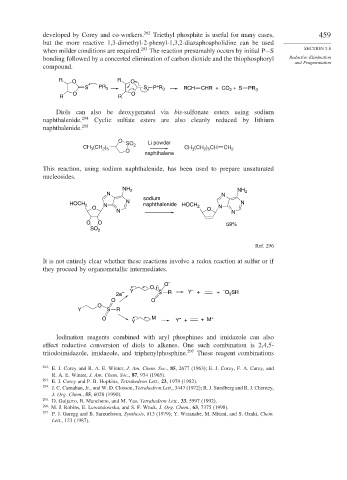Page 486 - Advanced Organic Chemistry Part B - Reactions & Synthesis
P. 486
developed by Corey and co-workers. 292 Triethyl phosphite is useful for many cases, 459
but the more reactive 1,3-dimethyl-2-phenyl-1,3,2-diazaphospholidine can be used
when milder conditions are required. 293 The reaction presumably occurs by initial P−S SECTION 5.8
bonding followed by a concerted elimination of carbon dioxide and the thiophosphoryl Reductive Elimination
and Fragmentation
compound.
R O R O
+
S PR 3 – S P R 3 RCH CHR + CO + S PR 3
2
O O
R R
Diols can also be deoxygenated via bis-sulfonate esters using sodium
naphthalenide. 294 Cyclic sulfate esters are also cleanly reduced by lithium
naphthalenide. 295
O Li powder
SO 2
CH (CH ) CH (CH ) CH CH 2
2 5
3
3
2 5
O
naphthalene
This reaction, using sodium naphthalenide, has been used to prepare unsaturated
nucleosides.
NH 2 NH
N N 2
sodium
N N
HOCH 2 N naphthalenide HOCH 2 N
O O
N N
O O 59%
SO 2
Ref. 296
It is not entirely clear whether these reactions involve a redox reaction at sulfur or if
they proceed by organometallic intermediates.
O –
O – –
–
2e – Y S R Y + + O SR
3
O O
O
Y S R
–
O M Y + + M +
Y
Iodination reagents combined with aryl phosphines and imidazole can also
effect reductive conversion of diols to alkenes. One such combination is 2,4,5-
triiodoimidazole, imidazole, and triphenylphosphine. 297 These reagent combinations
292
E. J. Corey and R. A. E. Winter, J. Am. Chem. Soc., 85, 2677 (1963); E. J. Corey, F. A. Carey, and
R. A. E. Winter, J. Am. Chem. Soc., 87, 934 (1965).
293 E. J. Corey and P. B. Hopkins, Tetrahedron Lett., 23, 1979 (1982).
294
J. C. Carnahan, Jr., and W. D. Closson, Tetrahedron Lett., 3447 (1972); R. J. Sundberg and R. J. Cherney,
J. Org. Chem., 55, 6028 (1990).
295 D. Guijarro, B. Mancheno, and M. Yus, Tetrahedron Lett., 33, 5597 (1992).
296 M. J. Robins, E. Lewandowska, and S. F. Wnuk, J. Org. Chem., 63, 7375 (1998).
297
P. J. Garegg and B. Samuelsson, Synthesis, 813 (1979); Y. Watanabe, M. Mitani, and S. Ozaki, Chem.
Lett., 123 (1987).

